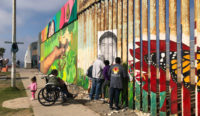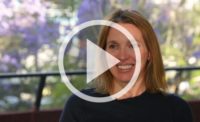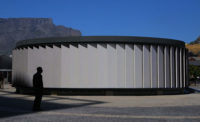The invisible line that separates the United States and Mexico has been much in the news lately, with family separations of detained immigrants, the USMCA trade agreement, and, as the ultimate manifestation of the divide, of course: President Trump’s infamous wall. It was these topics and others that prompted Mexican architect and educator, Tatiana Bilbao, to create an academic initiative in the spring of 2018 that asked 13 studios from 12 schools of architecture in both the U.S. and Mexico to address the myriad questions springing from this stratification. “My idea was to give a response to the political situation we’re living in,” Bilbao told RECORD recently over the phone. “When Trump was elected and was saying Mexicans are criminals and drug dealers, and we must build a wall I asked, 'What can we do?' My first thought was that there is a lack of knowledge about who we are as a region, rather than as Mexicans or Americans. Our culture, our environment, and our economies are so linked—and this should be better understood.”
Hoping for an impact that extended beyond the two studios she was teaching at Columbia and Yale, Bilbao called friends in other architecture programs. Her brief for the studios asked the students to reconsider the relationship of these two nations as a single region, rather than as separate worlds, by exploring the many forms of their interdependency. The resulting student work underpins a new exhibition at the Yale School of Architecture Gallery, Two Sides of the Border. In a handsome installation—curated by Bilbao’s teacher’s assistant at Yale, Nile Greenberg—drawings and models are displayed along four long tables at the gallery’s center, addressing issues ranging from labor contributions for food production to housing prototypes to proposals for water infrastructure. But the jury's out on what, exactly, is what, as the absence of explanatory text leaves visitors drifting between the displays in a kind of guessing game to unlock the mysteries behind each. One wall of the space holds a collection of maps—both historic and those created specifically for the show by mapmaker Thomas Paturet—that underscore the varied ways borders can be defined. Other walls display the photographs of RECORD contributing photographer, Iwan Baan, who traveled to all the studio sites. The images, devoid of human presence and haunting in their stillness, capture vastly different places (from the dune fields of Chihuahua to a brightly hued “paleteria,” or ice cream shop, in Ulysses, Kansas) uniting them—perhaps ironically, given the social explorations of the studio—through their depictions of lifelessness.
As one who crosses the border regularly, living in Mexico and teaching in the U.S., Bilbao says she saw this initiative, which opens channels of communication (in the academic realm at least), as her duty. And she hopes the exhibition will help promote the topic as a recurrent focus of study in schools. The cultural issues the studios have brought to light have been broad and, in some cases, quite surprising, says Bilbao. “Who would have thought that rural areas in Mexico would now have shingle houses done with concrete? That is crazy!” she says of the merging of American style with Mexico’s predominant building material. And in Ulysses, the population has shifted from one that was all white to become largely Mexican, driven by local agricultural jobs. “The streetscape, the shops and the things they sell, the rituals have changed,” says Bilbao. “And it’s the same thing, the other way around, in San Miguel de Allende: now the majority are Americans—retirees. A lot of things are happening in a fast-track way that we have not grasped.”
The exhibition Two Sides of the Border is open through February 9, 2019, at the Yale School of Architecture Gallery. It will travel to Berlin in March, and the material will be incorporated into a book, published by Lars Müller, with additional contributors.










